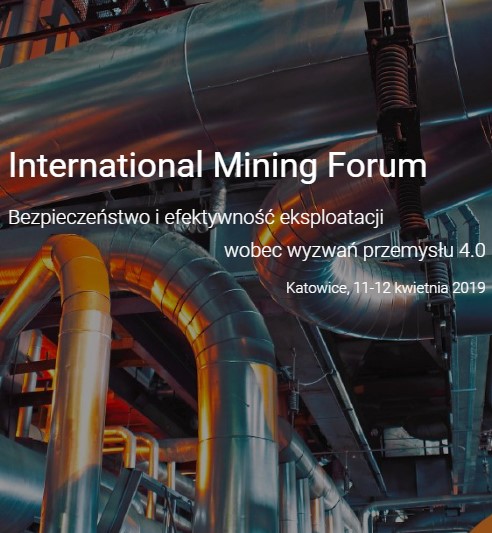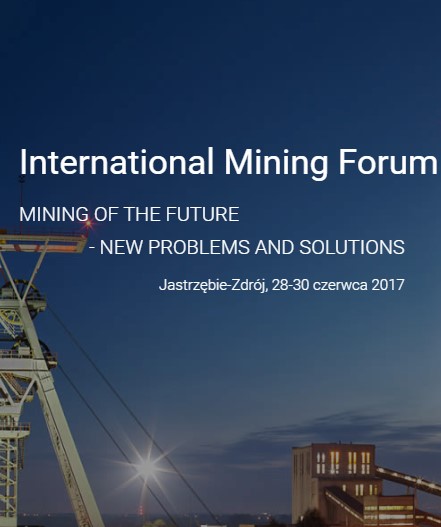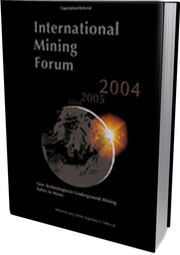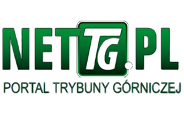Assessing Market Attractiveness of Power Generation Industry Companies for Hard Coal Producers
Paweł Bogacz
AGH - University of Science & Technology,
The Faculty of Industrial Economics and Management, Cracow, Poland
ABSTRACT: The paper presents the construction of a method used for detailed survey of power and power-and-heat generation plants’ market attractiveness, which in the author’s opinion could become a basis for creating marketing strategies of coal mines in Poland. In the construction of this method the relationship marketing idea was used and the analytical process presented was based on multidimensional comparison analysis and expert analysis tools. To illustrate the proposed method the paper contains an example based on a survey of the power generation industry and Kompania Węglowa S.A.
KEYWORDS: Marketing, market attractiveness, managing customer services, power generation in-dustry, power plant, power-and-heat generation plant, mining company
Modification of Gas Generator Parameters to the Thermo-Dynamical Processes of Underground Coal Gasification
Volodymyr I. Bondarenko, Volodymyr Falshtynskiy, Roman Dychkovskiy
National Mining University, Dnipropetrovsk, Ukraine
Zbigniew Szymczak
Polish Laboratory of Radical Technologies, Poland
Influence of Footwall Rocks Deformations on Stressed Condition of “Support-Rockmass” System
Volodymyr I. Bondarenko, Iryna A. Kovalevska
Gennadiy A. Simanovich, Vadym V. Fomichov
National Mining University, Dnipropetrovsk, Ukraine
Improvement of Equipment and Methods for Thin Coal Strata Mining in Western Donbass
V.I. Buzilo, V.P. Serduk, A.G. Koshka, T.I. Morozova
National Mining University, Ukraine
Energy Policy of Poland in the Beginning of 20th Century in the Opinion Polish Society - Results of the Survey
Alicja Byrska-Rąpała
AGH - University of Science and Technology, Faculty of Management, Cracow, Poland
ABSTRACT: When observing the energy balance structure of the world, European Union or de-veloped countries, such as the USA, Germany or France, one can see the directions of modern po-wer industry. Ecological sources of energy: natural gas, crude oil have become dominant, also, the role of hydroelectricity is increasing. The share of coal – the fuel of the 20th century – is decreas-ing. Poland is one of the three world’s countries, which base their energy industry on coal. The con-sumption of other primary sources of energy – crude oil, natural gas and hydroelectricity is low, and there are still no nuclear plants built, although works on them were quite advanced in the ‘80s and the beginning of the ‘90s. The old-fashioned energy balance structure in Poland is due to low energy consciousness of the Polish society, which is unaware of the significant discrepancy between Polish energy culture and energy policy of the European Union and other countries of the continent.
The paper presents the results of the opinion survey on energy consciousness of the Polish peo-ple. The survey concerned consumption structure of primary energy sources in their own country, the European Union and six selected countries. The results of the sample of Polish students were compared with the results of Finnish and Italian students, who had been given an identical question-naire.
KEYWORDS: Energy consciousness, environment consciousness, sociology, energy sector, coal, crude oil, natural gas, nuclear energy, renewable energy
A Mining Software System at “Bogdanka” S.A. Underground Coal Mine – an Important Implementation of an Integrated Mineral Deposit Management System in the Polish Mining Industry
Jerzy Kicki
AGH - University of Science and Technology,
Department of Underground Mining, Cracow, Poland
Polish Academy of Sciences, Mineral and Energy Economy Research Institute, Cracow, Poland
Artur Dyczko
Polish Academy of Sciences, Mineral and Energy Economy Research Institute, Cracow, Poland
ABSTRACT: The characteristic feature of a modern civilization is intensification of economic de-velopment and associated with it consumption of mineral resources. Fear as to their sufficiency is therefore quite understandable, particularly with respect to non-renewable resources. The more so that the growth experienced by industrial production in the 20th century grew more than ten times and in the period after World War II consumption of mineral resources reached a level equal to their total production during the whole past history of mankind. The fear accompanies humankind from the dawn of history and is a result of the role mineral resources play in the development of a civili-zation [1].
Considering the above, any projects focused on optimization of deposit extraction should be con-sidered worthy of attention. One of them – in the opinion of the authors of this paper – is undoub-tedly a project aimed at building a computer system to aid decision-making in the process of pre-paring a deposit for extraction. The paper characterizes the basic assumptions underlying the frame-work of such a system and describes the key parameters of the implementation project currently under way at “Bogdanka” S.A. Coal Mine for a number of years consistently the best-performing under-ground hard coal mine in Poland – in which the authors are involved [2].
International Trends in Standards and Regulations for Valuation of Mining Industry Properties and Projects
Trevor R. Ellis
Mineral Property Valuer, Ellis International Services, Inc., Denver, Colorado, USA
Chairman, Extractive Industries Expert Group,
International Valuation Standards Committee, London
ABSTRACT: Real property valuation standards have been applied under limited circumstances to market valuations of minerals and petroleum properties for decades. Generally, these have been app-lied because the valuation was for use in court. This paper reviews the brief evolution of mineral valuation standards, from the 1995 publication of the first edition of The VALMIN Code in Aus-tralia, to the current edition of the International Valuation Standards. It provides a global perspecti-ve on the need for this set international standards. Recommendations are provided on the implemen-tation of valuation standards within the extractive industries by government agencies, financial re-gulators, and professional societies, while advising on avoidance of conflicts between international and national standards. It addresses the shortage of valuers who are certified for valuation of mine-rals and petroleum industry assets using standards based on the Generally Accepted Valuation Prin-ciples (GAVP). Recommendations are made for valuer education and to solve licensing problems for working across borders.
KEYWORDS: Mineral valuation standards, regulations, International Valuation Standards, mineral valuer licensing, valuer education, appraiser, appraisal, financial reporting
Development of the International Valuation Standards Committee’s Best Practice Guidelines for Valuations in the Extractive Industries
Trevor R. Ellis
Mineral Property Valuer, Ellis International Services, Inc., Denver, Colorado, USA
Chairman, Extractive Industries Expert Group,
International Valuation Standards Committee, London
ABSTRACT: In early 2008, the International Valuation Standards Committee (IVSC) will release the exposure draft of its Extractive Industries Technical Paper for public comment. The document has been in development for almost four years. Development began many months before the associa-ted standards in the Extractive Industries Guidance Note received final approval for 2005 publica-tion. The primary purpose of the document is to provide best practice valuation guidelines for ex-tractive industries applications of the International Valuation Standards (IVSs). The document inter-prets the meaning and implications of a number of important parts of the IVSs for their application to valuations within the minerals and petroleum industries. The document describes in detail the app-lication of the Generally Accepted Valuation Principles to extractive industries valuation. It also pro-vides best practice guidance on many technical matters for minerals and petroleum valuations. The Technical Paper is expected to be finalized and published during 2008 by the IVSC.
KEYWORDS: International Valuation Standards Committee, Extractive Industries Technical Paper, minerals and petroleum valuation standards, best practice
Inherent Conflict of Individual and Group Rationality in Relations of a Lignite Mine and a Power Plant
Leszek Jurdziak
Institute of Mining Engineering, Wroclaw University of Technology, Wroclaw, Poland
ABSTRACT: Based on the newest results of economic analyses of operation of a lignite opencast mine and a power plant treated as a bilateral monopoly their relation has been described using game theory language. In such a tandem there is an inherent conflict of individual and group rationality – a conflict of maximization of own profit of both sides and maximization of joint profits. The mine has the information advantage (knows the deposit) and can always apply its predominant strategy – the optimal adjustment to changes of lignite prices. In order to secure acceptance of the solution maximizing joint profits (optimal in the Pareto sense) it is proposed to treat the negotiation between lignite mines and power plants as a cooperative, two-stage, two-person game with non-zero sum in which in the first stage both sides should select the ultimate pit maximizing joint profits and in the second one the agreement should be achieved regarding profit division (determination of the trans-fer price of lignite). It is proposed to use Nash bargaining solution in finding the accepted profit di-vision but due to the conflict of interests only the full vertical integration of both sides can secure the Pareto optimal solution.
Method of Identification of Mineable Lignite Reserves in the Bilateral Monopoly of an Open Pit and a Power Plant
Leszek Jurdziak, Witold Kawalec
Institute of Mining Engineering, Wroclaw University of Technology, Poland
ABSTRACT: In comparison to old approach used in Poland for ore reserves and mineral resources classification the new methodology of geological, mining and economic data processing is propo-sed to estimate mineable reserves of lignite for electric power generation. In order to achieve Pareto optimal solution which assures the highest level of resources utilization it is necessary to apply the pit optimization methods and the newest results of the analysis of modified bilateral monopoly of opencast lignite/coal mine and mine-mouth power plant.
Conditional and Monte Carlo Simulation - the Tools for Risk Identification in Mining Projects
Leszek Jurdziak, Justyna Wiktorowicz
Institute of Mining Engineering, Wroclaw University of Technology, Poland
ABSTRACT: Based on the simple example of several investment schemes having the same expec-ted value of cash flows but different volatility it has been shown that Monte Carlo simulation, when applied without any risk reduction techniques as e.g. hedging, does not reduce risk but only reveals it. Observation of cash flow variability in an investment scheme allows on proper selection of risk-adjusted discount rate for the given project. Monte Carlo simulation only shows potential risk, which can be measured also as the probability of loss, which increases with growing cash flow volatility despite expected NPV is constant. The risk of loss can be treated as the additional measure of risk connected with different investments. Introduction and popularity of VAR techniques in a finance sector encourages its application also in evaluation of mining projects. It has been also shown that the evaluation of mining projects should be based on the optimal life of mine schedules utilizing results of conditional simulation of ore body parameters in 3D due to only this approach allows on the proper estimation of cash flow variability in different years of mining project development.
Fuzzy Modelling of an Ultimate Pit
Witold Kawalec
Institute of Mining Engineering, Wroclaw University of Technology, Poland
ABSTRACT: An idea of fuzzy modelling of an ultimate pit especially suitable for lignite deposits has been presented. For a lignite deposit various economic models that are dependent on the arbitrary choice of the lignite price formulae can be created. On a contrary to a standard grade based price formulae these formulas can change the classification of the deposit and – consequently – signifi-cantly change the Life-Of-Mine Plan. The fuzzy modelling of an ultimate lignite pit built with the use of the standard Lerchs-Grossmann algorithm for the various, alternative price formulas has been implemented as a tool for economic evaluation of the lignite deposit. The case study of the ultimate pit created for the small lignite deposit has been shown.
About a Need for Polish Code for Mineral Asset Valuation
Jerzy Kicki
AGH - University of Science & Technology, Polish Academy of Sciences, MEERI, Cracow, Poland
Piotr Saługa
Polish Academy of Sciences, MEERI, Cracow, Poland
ABSTRACT: Polish mining industry has not developed yet complete standards for mineral (and/or petroleum) asset valuation. The problem of mineral asset valuation arose in the early ‘90s, caused by political system transformation. Unfortunately, Polish law has not kept up with transformation pace. Therefore in Poland, any kind of mineral asset valuation procedure or valuator competency rules haven’t existed yet. This paper delivers a proposal of such a valuation standard called “POLVAL – Mineral Asset Valuation Code”.
Strategy of Development and Value Creation in Mining Industry on Example of Lundin Mining Corporation
Arkadiusz Kustra
AGH - University of Science & Technology, Cracow, Poland
Krzysztof Kubacki
KGHM Lubin, Poland
ABSTRACT: Strategies of mining companies concentrates on building up of value creation through specific key drivers. One of them is development of deposits which mining companies may acquire by mergers and acquisition or by realizing their own mining projects.
Lundin Mining Corporation can serve as a perfect example of how fast end efficiently a mining company is able to grow and create value for its shareholders. In an industry characterized by long-term investments it has transformed from a small prospecting company to a diversified senior mi-ning company within a very short time. It has done so with methodical approach to value creation and aggressive development strategy. Company’s assets together with development projects and ex-ploration portfolio enable Lundin to grow further and strengthen its position in the extractive industry.
Prospects of Miner Development in Rivne-Volyn Region of Ukraine
Z. Malanchuk, V. Gurin, M. Girol
National University of Water Management and Nature Resources Use, Rivne, Ukraine
Repairless Maintenance of Development Workings at Exploitation of Thin Flat Coal Seams on Large Depths
Volodymyr Ju. Medjanik
National Mining University, Dnipropetrovsk, Ukraine
Pawlo P. Korz
Supreme Soviet of Ukraine
ABSTRACT: Parameters of a way of protection by strips of variable rigidity for a reuse of working workings are proved at the combined mining method of flat seams on large depths.
Parameters of perfecting safety method of protection for repeated using development working by strips of variable rigidity while using combined system of flat seam working on the large depths are considered.
Longitudinal and Transversal Stability of Mechanized Supports’ Sections
Mykola P. Ovchynnikov, Olexander I. Koval
Maintenance of a Mine Working Behind the Longwall Front Using Roof Bolting
Andrzej Nierobisz
Central Mining Institute, Katowice, Poland
ABSTRACT: The paper presents the way of maintenance of a mine working behind the longwall front using roof bolting. This technology was based on the use of roof bolts about 6.0 m in length with underslung straight sections of V-25 support in the axis of the excavation. In the work the way of design realisation, its implementation in practice and obtained measurement results were descri-bed.
KEYWORDS: Rock mass, longwall gate roads, support, bolting
Capacity of an Abandoned Coal Mine Converted into High Pressure CO2 Reservoir
Jan Palarski, Marcin Lutyński
Wydział Górnictwa i Geologii, Instytut Eksploatacji Złóż, Politechnika Śląska, Gliwice, Poland
ABSTRACT: In the article the concept of high pressure CO2 storage in an abandoned coal mine is presented. Storage of CO2 in abandoned coal mines is considered as one of the options of CO2 se-questration. For the purpose of the study volume of mine voids in one of the polish coal mines was estimated. Storage capacity of a coal mine is the sum of CO2 stored in mine voids, dissolved in mi-ne-water and adsorbed on coal. The amount of CO2 stored in mine voids and dissolved in water was calculated with the use of CO2-VR programme. Sorption capacity of a coal from a case-study mine was measured in a laboratory using volumetric adsorption apparatus. Experiments were per-formed at in-situ temperature of 22°C and 29°C. Results of the experiments were fitted into Lang-muir adsorption model and Gibbs and absolute adsorption isotherms were plotted. Calculation of coal storage capacity was calculated based on absolute Langmuir constants and remaining coal re-serves (mine losses). Storage capacity of a mine is mainly determined by CO2 sorption on coal and was estimated to be 8 089 165 t. Out of the total amount of CO2 stored, 56.5% (including ascertai-ned potential) would be adsorbed on coal, 35.6% would be stored in mine voids and only 7.9% would be dissolved in water. The main factor influencing the storage capacity of a mine is not the sorption capacity of coal determined in laboratory but the remained reserves accessible for sorp-tion. Storage capacity of a mine is also strongly limited by maximum allowable pressure of sealed shafts and overburden.
Application of WTP and WTA Categories in Valuation of Natural Resources
Krystian Pera
University of Economics, Katowice, Poland
ABSTRACT: The main issue of this study concerns problems of the natural environment evaluation. The starting point of analysis undertaken is the theory of neoclassical economy. The instruments that enable to estimate the value mentioned, the Willingness to Pay (WTP) and the Willingness to Ac-cept (WTA) were assumed. These instruments were introduced from Hicks’s prosperity measure: Compensating Variation (CV) and Equivalent Variation (EV).
Twofold depiction of this issue was presented (analytical and graphical) in two possible cases: the improvement of environmental quality and deterioration of its condition.
Another analysed issue was the consumer surplus, which together with total expense on the achie-ving specific level of the environmental quality, can be treated as a measure of complete value of the environment.
In the final part of the study, the difficulties connected with the measurement of the surplus we-re presented and also four variations were described: Quantitative and Price Compensating and also Price and Quantity Equivalent.
KEYWORDS: Natural resources, Willingness to Pay, Willingness to Accept, valuation of natural resources
Determination of the Size of the Fracture Zone Around a Road Working Based on the Results of Underground Convergence Measurements and Numerical Modelling
Stanisław Prusek
Central Mining Institute, Katowice, Poland
ABSTRACT: The publication presents the results of trials aiming at the determination of fracture zones around road workings exposed to the direct impact of the extraction pressure. The range of these zones was determined by means of the computer program Phase2, which is based on the finite element method. The basis for the determination of rock mass destruction zones constituted the Hoek-Brown criterion for an elastic-plastic medium and the results of underground measurements of vertical and horizontal convergence as well as floor upheaval in roads.
KEYWORDS: Safety, mining, road support
The Estimation of a Rock Slope Stability on the Base of Failure Criterion
A. Shashenko, O. Sdvizhkova, S. Polischuk, N. Khozjajkina
ABSTRACT: The stress state of rock bench has been investigated by finite element method. The surface of sliding has been defined on the base of phenomenological failure criterion.
The Knothe Theory in the World Mining
Anton Sroka
Technical Mining University, Freiberg, Germany
Mining Efficiency Increase by Using Energy Saving Technologies
A.G. Temchenko, V.S. Morkun, V.D. Sidorenko
Kryvyi Rih Technical University, Krivyi Rih, Ukraine
Standardized Measure of Discounted Future Net Cash Flows Related to Proved Oil and Gas Reserves and Capitalised Costs of Exploration and Development As Two Ways to Include Oil and Gas Assets’ Valuation in Financial Statements
Robert Uberman
The Andrzej Frycz Modrzewski University College, Cracow, Poland
Executive Committee Member of the Polish Association of Mineral Assets Valuation
ABSTRACT: Financial Statements of the biggest four global oil companies are analyzed to inden-tify how Standardized Measure of Discounted Future Net Cash Flows Related to Proved Oil and Gas Reserves and Capitalized Costs of Exploration and Development influence their market value.
KEYWORDS: Mineral deposits, valuation methods, SMOG, oil companies’ financial reporting
Power Generation Experience from Abandoned Coal Mines Methane
Zaneta Whitworth, S. Cuadrat, Rafał Lewicki
Biogas Technology Limited, Sawtry, Cambridgeshire, United Kingdom
ABSTRACT: Biogas Technology Limited presents two case studies of power generation from aban-doned mines methane, using modular generators based on reciprocating spark ignition engines. Re-sults of theoretical modelling and well tests are described together with comparison of the forecast and performance of the units. Experience gained form long term operation of numerous power ge-neration schemes and from leading projects based on the Kyoto protocol allowed to develop busi-ness offer in regard to capture and utilization of methane from coal beds, active and abandoned coal mines and air ventilation. Proven in practice testing and operational facilities can be provided, ba-sed on unique Biogas business model delivering turnkey solution at no cost to the project partners, from the source testing to realisation of the CERs and energy export.

 IMF 2019
IMF 2019
 IMF 2017
IMF 2017
 Archiwa IMF
Archiwa IMF





